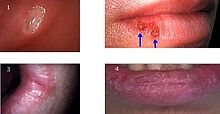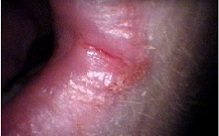Cheilitis

Cheilitis is a medical condition characterized by inflammation of the lips. According to its onset and course, cheilitis can be either acute or chronic. Most cheilitis is caused by acute sun exposure. Allergic tests may identify allergens that cause cheilitis.
Chapped lips

Chapped lips (also known as cheilitis simplex or common cheilitis) are characterized by cracking of the lips. The lower lip usually becomes inflamed. There may also be burning or the formation of large, painful cracks when the lips are stretched. Chronic cheilitis simplex can progress to crusting and bleeding.

Counterintuitively, constant licking of the lips causes drying and irritation, and eventually the mucosa splits or cracks. The lips have a greater tendency to dry out in cold, dry weather. Digestive enzymes present in the saliva may also irritate the lips, and the evaporation of the water in saliva saps moisture from them.

Some children have a habit of sucking and chewing on the lower lip, producing a combination of cheilitis and a sharply demarcated perioral erythema.
Treatment is usually successful with the use of topical medications Medical grade (USP) lanolin accelerates the repair of the lips.
Sometimes the term "cheilitis simplex" is used interchangeably with cheilitis in general; however, exfoliative cheilitis is also sometimes stated to be the equivalent of chapped lips.
Actinic cheilitis
Mainly caused due to sun rays and affects white peoples having low skin tone. There is a small risk that this condition can develop into squamous cell carcinoma in the long term, but lip cancer is usually noticed early and hence has a good prognosis compared to oral cancer generally.
Angular cheilitis

Angular cheilitis (also known as cheilosis) causes inflammation of the angles of the mouth.
There are many possible causes, including malnourishment, deficiencies (iron, B vitamins, folate), contact allergy, infection (Candida albicans, Staphylococcus aureus or β-hemolytic streptococci) and edentulism (often with overclosure of the mouth and concomitant denture-related stomatitis), and others.
Eczematous cheilitis
Also termed "lip dermatitis", eczematous cheilitis is a diverse group of disorders which often have an unknown cause. Chronic eczematous reactions account for the majority of chronic cheilitis cases.
It is divided into endogenous (due to an inherent characteristic of the individual), and exogenous (where it is caused by an external agent). The main cause of endogenous eczematous cheilitis is atopic cheilitis (atopic dermatitis), and the main causes of exogenous eczematous cheilitis is irritant contact cheilitis (e.g., caused by a lip-licking habit) and allergic contact cheilitis. The latter is characterized by a dryness, fissuring, edema, and crusting. It affects females more commonly than males, in a ratio of about 9:1.

The most common causes of allergic contact cheilitis is lip cosmetics, including lipsticks and lip balm, followed by toothpastes. A lipstick allergy can be difficult to diagnose in some cases as it is possible that cheilitis can develop without the person even wearing lipstick. Instead, small exposure such as kissing someone who is wearing lipstick is enough to cause the condition.
Allergy to Balsam of Peru can manifest as cheilitis. Allergies to metal, wood, or other components can cause cheilitis reactions in musicians, especially players of woodwind and brass instruments, e.g., the so-called "clarinetist's cheilitis", or "flutist's cheilitis". "Pigmented contact cheilitis" is one type of allergic cheilitis in which a brown-black discoloration of the lips develops. Patch testing is used to identify the substance triggering allergic contact cheilitis.
Infectious cheilitis
Infectious cheilitis refers to cheilitis caused by infectious disease. The terms "Candidal cheilitis" and "bacterial cheilitis" are sometimes used, denoting the involvement of Candida organisms and bacterial species respectively. The term "cheilocandidiasis" describes exfoliative (flaking) lesions of the lips and the skin around the lips, and is caused by a superficial candidal infection due to chronic lip licking. Impetigo (caused by Streptococcus pyogenes and/or Staphylococcus aureus), can manifest as an exfoliative cheilitis-like appearance.
Herpes labialis (cold sore) is a common cause of infectious cheilitis. A lesion caused by recurrence of a latent herpes simplex infection can occur in the corner of the mouth, and be mistaken for other causes of angular cheilitis. In fact this is herpes labialis, and is sometimes termed "angular herpes simplex".
Granulomatous cheilitis
Orofacial granulomatosis is enlargement of lips due to the granulomatous inflammation. "Median cheilitis" may be seen, which is fissuring in the midline of the lips due to the enlargement of the lips. Angular cheilitis may also be associated with orofacial granulomatosis.
A related condition is Melkersson–Rosenthal syndrome, a triad of facial palsy, chronic lip edema, and fissured tongue. "Miescher’s cheilitis", and "granulomatous macrocheilitis", are synonyms of granulomatous cheilitis.
Common causes of drug-related cheilitis include Etretinate, Indinavir, Protease inhibitors, Vitamin A and Isotretinoin (a retinoid drug). Uncommon causes include Atorvastatin, Busulphan, Clofazimine, Clomipramine, Cyancobalamin, Gold, Methyldopa, Psoralens, Streptomycin, Sulfasalazine and Tetracycline.When administration of these drugs are stopped condition gets normalized.[33]
Exfoliative cheilitis
Also termed "cheilitis exfoliativa" or "tic de levres", is an uncommon inflammatory condition of the lips, which are painful and crusted.There is formation of white thin crust over the lips which form and shed continuously. Although there may be associated erythema and edema. The condition has not yet been attributed to any particular cause. Rarely are infections to blame. In some individuals, there is an association with stress, anxiety, depression or personality disorders. In one report, 87% of individuals had some form of psychiatric disturbance, and 47% had thyroid dysfunction, which in turn can cause psychiatric conditions like depression.
Some cases of exfoliative cheilitis are thought to represent factitious damage, termed "factitious cheilitis" or "artifactual cheilitis", and are related to repetitive lip picking or licking habits. This appears as crusting and ulceration caused by repetitive chewing and sucking of the lips. Some consider habitual lip licking or picking to be a form of nervous tic. This habit is sometimes termed perlèche (derived from the French word pourlècher meaning "to lick one’s lips"). Factitious cheilitis is significantly more common in young females.
Exfoliative cheilitis has also been linked to HIV/AIDS. Management consists mostly of keeping the lips moist and the application of topical corticosteroids ranging from hydrocortisone to clobetasol. There have also been reports of using topical tacrolimus ointment.
Cheilitis glandularis
This is an inflammatory condition of the minor salivary glands, usually in the lower lip, which appears swollen and everted. There may also be ulceration, crusting, abscesses, and sinus tracts. It is an acquired disorder, but the cause is uncertain. Suspected causes include sunlight, tobacco, syphilis, poor oral hygiene and genetic factors. The openings of the minor salivary gland ducts become inflamed and dilated, and there may be mucopurulent discharge from the ducts. A previous classification suggested dividing cheilitis into 3 types based on severity, with the later stages involving secondary infection with bacteria, and increased ulceration, suppuration and swelling: Type 1, Simple; Type 2, Superficial suppurative ("Baelz's disease"); and Type 3, Deep suppurative ("cheilitis glandularis epostemetosa"). Cheilitis glandularis usually occurs in middle-aged and elderly males, and it carries a risk of malignant transformation to squamous cell carcinoma (18% to 35%). Preventative treatment such as vermilionectomy ("lip shave") is therefore the treatment of choice.
Plasma cell cheilitis
Plasma cell cheilitis appears as well defined, infiltrated, dark red plaque with a superficial lacquer-like glazing. Plasma cell cheilitis usually involves the lower lip. The lips appear dry, atrophic and fissured. Angular cheilitis is sometimes also present.
Other causes
- Lupus erythematosus, sometimes termed "lupus cheilitis".
- Crohn's disease (angular cheilitis).
- "Nutritional cheilitis", e.g. pyridoxine (vitamin B6) deficiency.
- Lichen planus.
- Pemphigoid.
- Xerostomia.